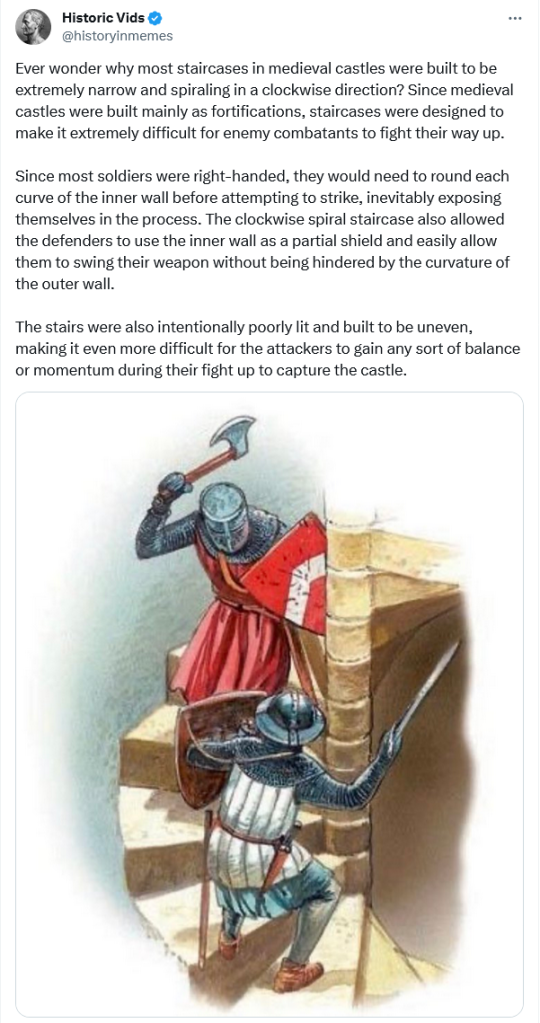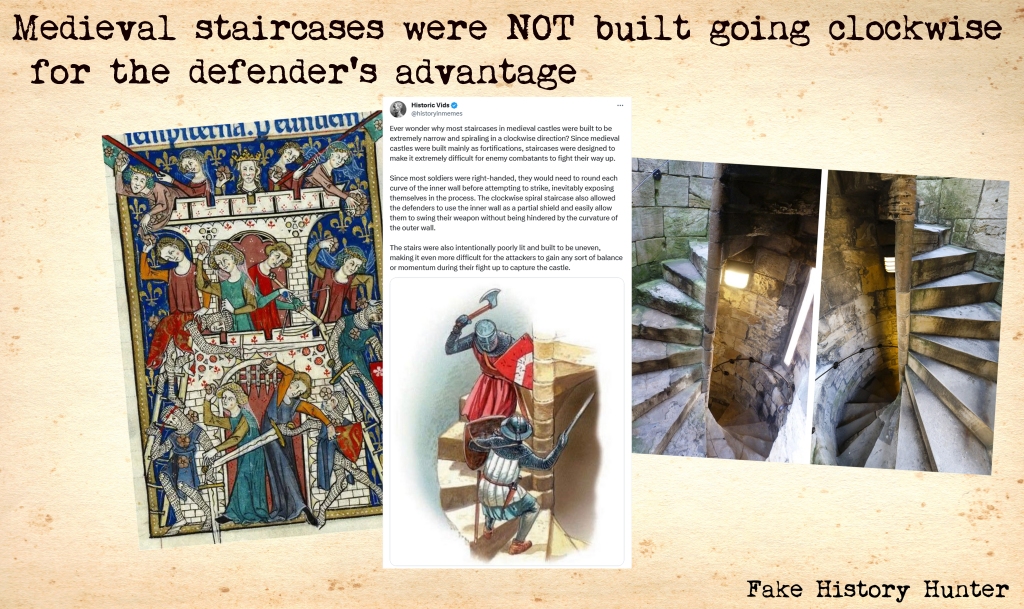This story has been making the rounds on the internet with a claim that you’ve probably been told during visits to castles, but, there’s no evidence for it whatsoever.

In short the idea is that it’s easier for a right-handed soldier or knight to fight in a spiral staircase that is built going clockwise when they were defending the castle as they had space to swing their weapon from above while the attacker coming from below would find this more difficult.
Like many myths that stick, the story at first makes sense.
So when we hear it from a guide during a castle tour, from our history teacher, or even on television documentaries, why would we doubt it?
But if you think about it a bit longer and start looking for evidence, you soon realise something is a bit iffy here.
For starters, there is no primary evidence, whatsoever, that the people who built, lived and fought in these castles built staircases in that way for that reason. During the Middle Ages, nobody wrote down that you should build staircases like this and why.
If it had been common knowledge among castle builders, then why are there still quite a lot (about 30%) of castles with counter-clockwise staircases?
Why 70% of them were built clockwise is up for debate, of course.
Some castles, like Clifford’s tower, had both and it seems this may have been for traffic going in different ways and thus having both types might have simply improved flow-through.
And going downstairs is often trickier than going upstairs and it might help to have somewhere to place your right hand when descending, it also gives your right foot more space on the steps if the stairs go clockwise
Or maybe it was just custom, what builders were used to, maybe it was easier for them to built stairs that went clockwise as right handed stone masons?
Or maybe it just depended on where there was space for a staircase and how it would connect to the rest of the building, a simple, logical architectural functional reason.
Until we find some medieval records explaining the castle builder’s choice to built stairs one way or another we just can’t say for sure what they were thinking.
But 30% is a big enough number to suggest that there was not an overwhelming consensus that stairs going one way or another was better.
And no, before you start, there’s no evidence of the Kerrs being left handed, that’s probably an 19th century (yes, them again) myth.
The Tower of London, one of the most important castles in England, where royalty live(d) has counter-clockwise stairs!
If medieval people thought this would give the defenders not an advantage, surely they would have fixed it, especially in this castle!

So the defenders didn’t mind if they weren’t at an advantage when the enemy took the right stairs?
Another reason why we know this story is a myth is that it also doesn’t make a lot of sense when you study medieval combat involving castles.
Castle builders knew that it didn’t really make a huge difference which way the stairs go, they’re not suitable for fighting at all, neither party has a lot of space to wield those long,
pointy, sharp weapons but even with daggers or short swords the situation is just very impractical.
The person below you has the advantage of jabbing at your legs and feet while they can protect their head with their helmet and shield.
Of course one of the few options you’d have to win would be by pushing your enemy back down the stairs and then with whoever is left with you, to retake the entire castle.
Frankly, if you find yourself in this cornered position the castle is probably already lost.
Sure, you can still hold out for some time, being above your enemy is a good strategic position, but only if you also have enough water & food to last.
Which becomes more unlikely the further you’re pushed back as a well and your food storage are usually not somewhere high up in the castle but in stead at the lowest point, where the enemy already is.
Again, when you get to the point that people are rushing up the stairs, you’re in the end-phase.
But still, if you continue to fight a better way to stop your enemy than encountering them halfway down the steps would be to block the stairs by throwing heavy furniture and everything else you can find down it while you then wait at the top of the stairs where you have more space to fight and where your enemy really is at a disadvantage as they’re still on the stairs below you.
Either way now would be a good time to start considering surrender, a glorious death in combat or jumping out the window.
For attackers it’s also not a very tempting scenario.
If you’ve already breached all the outer walls and defeated all the soldiers there and have reached so far into the castle that you’re at the foot of stairs, you’re very close to victory and who would want to risk their life crawling up some stairs where the defenders are waiting for you?
Sieges often didn’t involve much fighting at all, as simply waiting outside the castle till the people inside ran out of water and food was a much easier and less bloody way to win.
In many cases simply realising the enemy was going to sit outside and wait was enough reason to surrender.

Yes those defenders are all women.
So in conclusion: there’s no evidence for this claim and it also doesn’t make a lot of sense.
This, like SO MANY myths about the middle ages can very likely be credited to the Victorians, well technically an Edwardian, but still, same generation.
One Sir Theodore Andrea Cook with a fancy moustache has a theory and for over a century everyone just blindly believes it.
Yes, that seems to be the oldest source we have for anyone thinking the direction of spiral staircases helps defenders in castles.
Until we find evidence for medieval people believing that one type of stairs was better than another, we can say that the old idea that favours the clockwise version for tactical reasons is a myth.
As far as I know we’re yet to find ANY medieval source that writes about why spiral staircases should go one way or another.
For more research & the opinions of historians, archaeologists & other experts check the sources below.
Also, stairs were used to go up and down floors, they were not dimly lit or built to be uneven on purpose as you wouldn’t want servants, soldiers but also the lords and ladies themselves falling down them all the time.
“Oh no Lord Dave has fallen down the stairs and broken his neck because we have no lights and dodgy steps in the tower just in case there’s a siege even though we haven’t had one in generations….”
And if you’re trained in medieval combat and have access to some castle stairs, please do some experimenting, try if you can fight there and make a video of it, I’ll share it here!
I’ve been trained in sword fighting but also with a short dagger but sadly never got a chance to try this on some medieval stairs myself.
Do be careful & responsible though, I won’t take responsibility for you damaging yourself or worse, the castle 😉
Sources:
- Fake History, 101 things that never happened, by J.H.Teeuwisse
- ‘The Rise of the Anti-clockwise Newel Stairs’, research by the Castle Studies Group (pdf link)
- Medievalists.net
- Triskele Heritage
- Tales of times forgotten
- Newcastle Castle
- r/AskHistorians
If you enjoy my writing check out my book!
If you like my work, please consider supporting me on Patreon;
Disclaimer;
Picture(s) found online, used for (re-)educational purposes only.
I do not own the copyrights to these images, I only share them here for educational purposes to try and make sure the real story behind it becomes known and people will stop spreading false information.
If the copyright owner objects to the sharing here, kindly contact me and I shall alter the article.
If you’re interested in using any of the images here get in touch with the copyright owners mentioned in the article.
Feel free to contact me with questions.



